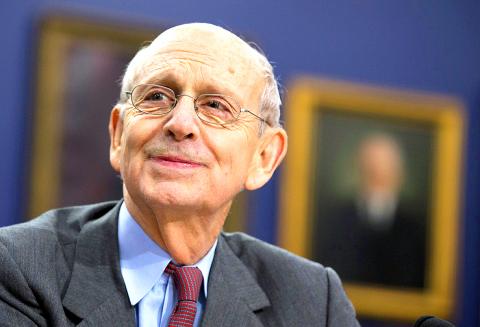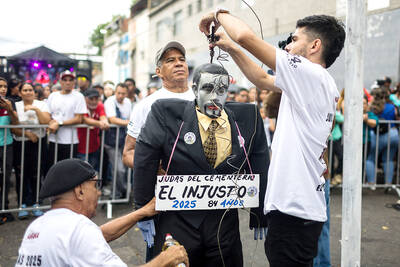A deeply divided US Supreme Court upheld the use of a controversial drug in lethal injection executions on Monday, even as two dissenting justices said for the first time they think it was “highly likely” the death penalty itself is unconstitutional.
On their last day together until the fall, the justices voted 5-4 in a case from Oklahoma that the sedative midazolam can be used in executions without violating the US Constitution’s Eighth Amendment, which prohibits cruel and unusual punishment.
The court was also divided 5-4 in a case upholding independent commissions that draw congressional districts in Arizona, California and 11 other states in a bid to reduce partisanship in electoral mapmaking. By a similar margin, the court called into question first-ever limits on emissions of mercury and other toxic pollutants from power plants, in a ruling that said the US Environmental Protection Agency failed to account for the cost of the regulations at the outset.

Photo: AP
In addition, the justices agreed to hear an important case from Texas about the use of race in college admissions for its term that begins in October.
The court also granted an emergency appeal from Texas abortion clinics to prevent the state from enforcing regulations that would close more than half the state’s 19 clinics. The justices voted 5-4 to grant an emergency appeal from the clinics after a federal appeals court upheld new regulations and refused to keep them on hold while the clinics appealed to the Supreme Court.
The Supreme Court order is to remain in effect at least until the court decides whether to hear the clinics’ appeal of the lower court ruling, which will not be until autumn. The court’s decision to block the regulations is a strong indication that the justices will hear the full appeal, which could be the biggest abortion case at the Supreme Court in nearly 25 years.
An opposite ruling would have allowed the state to move ahead with regulations requiring abortion facilities to be constructed like surgical centers.
In the dispute over the lethal injection drug, midazolam was used in Arizona, Ohio and Oklahoma executions last year. The executions took longer than usual and raised concerns that the drug did not perform its intended task of putting inmates into a coma-like sleep.
Justice Samuel Alito said for a conservative majority that arguments the drug could not be used effectively as a sedative in executions were speculative and he dismissed problems in executions in Arizona and Oklahoma as “having little probative value for present purposes.”
In a biting dissent, Justice Sonia Sotomayor said: “Under the court’s new rule, it would not matter whether the state intended to use midazolam, or instead to have petitioners drawn and quartered, slowly tortured to death or actually burned at the stake.”
Alito responded, saying: “The dissent’s resort to this outlandish rhetoric reveals the weakness of its legal arguments.”
In a separate dissent, Justice Stephen Breyer said the time has come for the court to debate whether the death penalty itself is constitutional. Justice Ruth Bader Ginsburg joined Breyer’s opinion. They stopped short of declaring their outright opposition to capital punishment.
“I believe it highly likely that the death penalty violates the Eighth Amendment,” Breyer said, drawing on cases he has reviewed in more than 20 years on the Supreme Court bench.
More than 100 death row inmates have been exonerated, showing that the death penalty is unreliable, Breyer said. He said it is also imposed arbitrarily, takes far too long to carry out and has been abandoned by most of the country. Last year, just seven states carried out executions, he said.
In 1972, the Supreme Court struck down every state’s death penalty laws. Some justices believed at the time that this decision would effectively end capital punishment. Instead, many states wrote new laws, and four years later the court reinstated the death penalty.

POLITICAL PRISONERS VS DEPORTEES: Venezuela’s prosecutor’s office slammed the call by El Salvador’s leader, accusing him of crimes against humanity Salvadoran President Nayib Bukele on Sunday proposed carrying out a prisoner swap with Venezuela, suggesting he would exchange Venezuelan deportees from the US his government has kept imprisoned for what he called “political prisoners” in Venezuela. In a post on X, directed at Venezuelan President Nicolas Maduro, Bukele listed off a number of family members of high-level opposition figures in Venezuela, journalists and activists detained during the South American government’s electoral crackdown last year. “The only reason they are imprisoned is for having opposed you and your electoral fraud,” he wrote to Maduro. “However, I want to propose a humanitarian agreement that

ECONOMIC WORRIES: The ruling PAP faces voters amid concerns that the city-state faces the possibility of a recession and job losses amid Washington’s tariffs Singapore yesterday finalized contestants for its general election on Saturday next week, with the ruling People’s Action Party (PAP) fielding 32 new candidates in the biggest refresh of the party that has ruled the city-state since independence in 1965. The move follows a pledge by Singaporean Prime Minister Lawrence Wong (黃循財), who took office last year and assumed the PAP leadership, to “bring in new blood, new ideas and new energy” to steer the country of 6 million people. His latest shake-up beats that of predecessors Lee Hsien Loong (李顯龍) and Goh Chok Tong (吳作棟), who replaced 24 and 11 politicians respectively

Young women standing idly around a park in Tokyo’s west suggest that a giant statue of Godzilla is not the only attraction for a record number of foreign tourists. Their faces lit by the cold glow of their phones, the women lining Okubo Park are evidence that sex tourism has developed as a dark flipside to the bustling Kabukicho nightlife district. Increasing numbers of foreign men are flocking to the area after seeing videos on social media. One of the women said that the area near Kabukicho, where Godzilla rumbles and belches smoke atop a cinema, has become a “real

‘WATER WARFARE’: A Pakistani official called India’s suspension of a 65-year-old treaty on the sharing of waters from the Indus River ‘a cowardly, illegal move’ Pakistan yesterday canceled visas for Indian nationals, closed its airspace for all Indian-owned or operated airlines, and suspended all trade with India, including to and from any third country. The retaliatory measures follow India’s decision to suspend visas for Pakistani nationals in the aftermath of a deadly attack by shooters in Kashmir that killed 26 people, mostly tourists. The rare attack on civilians shocked and outraged India and prompted calls for action against their country’s archenemy, Pakistan. New Delhi did not publicly produce evidence connecting the attack to its neighbor, but said it had “cross-border” links to Pakistan. Pakistan denied any connection to